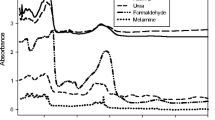Abstract
In this note, a preliminary test of the ability of visible and near infrared spectroscopy (NIR) coupled with multivariate statistical methods is described to predict the phenol-formaldehyde (PF) adhesive content in oriented strandboard (OSB) post manufacture. A visible-NIR-based PLS model could predict moderately well (RMSEP0=.60%) the PF loading in the face layers of pine OSB after pressing. The spectral absorbance at 614 nm was significantly different between PF loadings. NIR may provide the basis for an on-line, real-time quality control tool providing feedback information to the press.
Zusammenfassung
In dieser Studie wird ein Vorversuch bezüglich des Einsatzes von Spektroskopie im sichtbaren und im Nahinfrarotbereich (NIR) in Verbindung mit multivariaten statistischen Verfahren zur Vorhersage des Phenolformaldehydharzgehalts in hergestellten OSB-Platten beschrieben. Ein PLS-Modell unter Verwendung der spektroskopischen Daten konnte den Phenolformaldehydanteil (PF) in der Deckschicht von Kiefern-OSB nach dem Pressen relativ gut vorhersagen (RMSEP =0.60%). Das Absorptionsspektrum bei 614 nm unterschied sich je nach PF-Anteil. NIR hat somit das Potential zur Online-Echtzeit-Qualitätskontrolle, um Feedbackinformationen an die Presse weiterleiten zu können.
Similar content being viewed by others
References
Dai C, Yu C, Groves K, Lohrasebi H (2007) Theoretical modeling of bonding characteristics and performance of wood composites. Part II: resin distribution. Wood Fiber 39(1):56–70
Degamber B, Fernando GF (2004) A comparative study on the cure behaviour of thermal- and microwave-processed epoxy resin. J Near Infrared Spectrosc 12(4):221–231
Dessipri E, Minopoulou E, Chryssikos GD, Gionis V, Paipetis A, Panayiotou C (2003) Use of FT-NIR spectroscopy for on-line monitoring of formaldehyde-based resin synthesis. Eur Polym J 39(8):1533–1540
Horwath ED, Hutter T, Kessler R, Wimmer R (2005) Feedback and feedforward control of wet-processed hardboard production using spectroscopy and chemometric modeling. Anal Chim Acta 544(1–2):47–59
Lachenal G (1998) Structural investigations and monitoring of polymerization of NIR spectroscopy. J Near Infrared Spectrosc 6(1–4):299–306
Mbachu RA, Congleton TG (2005) NIR spectroscopic monitoring of resin-loading during assembly of engineered wood product. US Patent 6,846,446 B2
Rials TG, Kelley SS, So C-L (2002) Use of Advanced Spectroscopic Techniques for Predicting the Mechanical Properties of Wood Composites. Wood Fiber Sci 34(3):398–407
So C-L, Via BK, Groom LH, Schimleck LR, Shupe TF, Kelley SS, Rials TG (2004) Near Infrared Spectroscopy in the Forest Products Industry. For Prod J 54(3):6–16
So C-L, Eberhardt TL, Hsu E, Via BK, Hse CY (2007) Infrared spectroscopic monitoring of urea addition to oriented strandboard resins. J Appl Polym Sci 105(2):733–738
Tsuchikawa S (2007) A review of recent near infrared research for wood and paper. Appl Spectrosc Rev 42:43–71
Via BK, Eckhardt LG, So C-L, Shupe TF, Groom LH, Stine M (2006) The response of visible/near infrared absorbance to wood-staining fungi. Wood Fiber 38(4):717–726
Author information
Authors and Affiliations
Corresponding author
Rights and permissions
About this article
Cite this article
Taylor, A., Via, B.K. Potential of visible and near infrared spectroscopy to quantify phenol formaldehyde resin content in oriented strandboard . Eur. J. Wood Prod. 67, 3–5 (2009). https://doi.org/10.1007/s00107-008-0266-0
Published:
Issue Date:
DOI: https://doi.org/10.1007/s00107-008-0266-0




